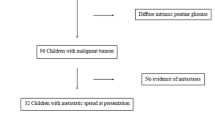Abstract
Background
Obstructive hydrocephalus is the most common complication of intracranial germ cell tumors (IGCTs). Although ventriculoperitoneal shunts (VPSs) were previously used for treating this condition, they have recently been replaced by endoscopic third ventriculostomy (ETV), as the latter can avoid various complications caused by a VPS and can preserve physiological cerebrospinal fluid (CSF) dynamics. Therefore, if a VPS malfunctioned in patients who had previously been treated for IGCTs, it seems reasonable to consider removing the problematic VPS, followed by ETV, as long as magnetic resonance imaging reveals third ventricle floor ballooning and the cause of obstruction in the ventricular system, which are indicators for ETV.
Case Presentation and Discussion
Here, we present the cases of three patients who underwent simultaneous removal of malfunctioning VPSs and ETV, more than 20 years (range 20–27 years) after initial treatment for IGCT and relevant obstructive hydrocephalus. Despite a relatively long shunt dependency, their obstructive hydrocephalus was well-managed by ETV, probably because CSF absorptive capacity remained intact after IGCT ablation by radio-chemotherapy.
Conclusion
Patients with previously treated IGCTs can thus be released from the need for a VPS, regardless of long-term shunt dependency.




Similar content being viewed by others
References
Louis DN, Ohgaki H, Otmar DW, et al. (2007) The 2007 WHO classification of tumours of the central nervous system. Acta Neuropathol 114:97–109
Edwards MSB, Hudgins RJ, Wilson CB, et al. (1988) Pineal region tumors in children. J Neurosurg 68:689–697. doi:10.3171/jns.1988.68.5.0689
Yamini B, Refai D, Rubin CM, Frim DM (2004) Initial endoscopic management of pineal region tumors and associated hydrocephalus: clinical series and literature review. J Neurosurg 100:437–441. doi:10.3171/ped.2004.100.5.0437
Boschert J, Hellwig D, Krauss JK (2003) Endoscopic third ventriculostomy for shunt dysfunction in occlusive hydrocephalus: long-term follow up and review. J Neurosurg 98:1032–1039. doi:10.3171/jns.2003.98.5.1032
Marton E, Feletti A, Basaldella L, Longatti P (2010) Endoscopic third ventriculostomy in previously shunted children: a retrospective study. Childs Nerv Syst 26:937–943. doi:10.1007/s00381-010-1130-1
Spennato P, Ruggiero C, Aliberti F, et al. (2013) Third ventriculostomy in shunt malfunction. World Neurosurg 79(S22):e21–e26. doi:10.1016/j.wneu.2012.02.005
Matsutani M (2001) Combined chemotherapy and radiation therapy for CNS germ cell tumors—the Japanese experience. J Neuro-Oncol 54:311–316
Sawamura Y, Ikeda J, Shirato H, et al. (1998) Germ cell tumours of the central nervous system: treatment consideration based on 111 cases and their long-term clinical outcomes. Eur J Cancer 34:104–110. doi:10.1016/S0959-8049(97)10045-4
O’Brien DF, Javadpour M, Collins DR, et al. (2005) Endoscopic third ventriculostomy: an outcome analysis of primary cases and procedures performed after ventriculoperitoneal shunt malfunction. J Neurosurg 103:393–400. doi:10.3171/ped.2005.103.5.0393
Prusseit J, Simon M, von der Brelie C, et al. (2009) Epidemiology, prevention and management of ventriculoperitoneal shunt infections in children. Pediatr Neurosurg 45:325–336. doi:10.1159/000257520
Sufianov A, Sufianova G, Iakimov I (2008) Neuroendoscopic procedures in achievement of shunt independence: outcome analysis of 28 patients with shunt malfunction. Minim Invasive Neurosurg 51:158–164. doi:10.1055/s-2008-1046760
Buxton N, Macarthur D, Robertson I, Punt J (2003) Neuroendoscopic third ventriculostomy for failed shunts. Surg Neurol 60:201–204
Chhun V, Sacko O, Boetto S, Roux FE (2014) Third ventriculocisternostomy for shunt failure. World Neurosurg 83:970–975. doi:10.1016/j.wneu. 2015.01.058
Nishiyama K, Mori H, Tanaka R (2003) Changes in cerebrospinal fluid hydrodynamics following endoscopic third ventriculostomy for shunt-dependent noncommunicating hydrocephalus. J Neurosurg 98:1027–1031. doi:10.3171/jns.2003.98.5.1027
Kulkarni AV, Drake JM, Kestle JRW, et al. (2010) Predicting who will benefit from endoscopic third ventriculostomy compared with shunt insertion in childhood hydrocephalus using the ETV success score. J Neurosurg Pediatr 6:310–315. doi:10.3171/2010.8.PEDS103
Melikian A, Korshunov A (2010) Endoscopic third ventriculostomy in patients with malfunctioning CSF-shunt. World Neurosurg 74:532–537. doi:10.1016/j.wneu.2010.08.005
Shono T, Natori Y, Morioka T, et al. (2007) Results of a long-term follow-up after neuroendoscopic biopsy procedure and third ventriculostomy in patients with intracranial germinomas. J Neurosurg 107:193–198. doi:10.3171/PED-07/09/193
Author information
Authors and Affiliations
Corresponding author
Ethics declarations
The Institutional Review Board of the Kanazawa University Hospital (#1718-2015) approved this retrospective review of patients’ medical records.
Conflict of interest
The authors report no conflict of interest concerning the materials or methods used in this study or the findings specified in this paper. This work was supported by KAKENHI (Grant-in-Aid for Exploratory Research to D.K.).
Rights and permissions
About this article
Cite this article
Kita, D., Hayashi, Y., Fukui, I. et al. Simultaneous ventriculoperitoneal shunt removal and endoscopic third ventriculostomy for three patients previously treated for intracranial germ cell tumors more than 20 years ago. Childs Nerv Syst 32, 1543–1547 (2016). https://doi.org/10.1007/s00381-016-3055-9
Received:
Accepted:
Published:
Issue Date:
DOI: https://doi.org/10.1007/s00381-016-3055-9




